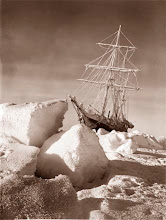Much as increasing levels of carbon dioxide in the atmosphere create a greenhouse effect that warms the Earth, new research that explores CO2 levels from 30 million-plus years ago found that lower levels of the gas helped the formation of the polar ice caps.
CO2 was on the low side during the Eocene-Oligocene (say that five times fast) climatic transition period and allowed the planet to chill enough for ice to form at the polar extremes.
It turns out the clues rested in the East African village of Stakishari in Tanzania. There scientists were able to precisely date the time where rocks of the period were formed. Those rocks, in turn, give a look at levels of various gases in the atmosphere so long ago.
The period marked the biggest change in the planets climate since the extinction of dinosaurs 65 million years ago.
Friday, September 25, 2009
Thursday, September 24, 2009
OK to get out that hair spray?

The ozone hole above Antarctica may be closing.
In another 90 years or so, it may close entirely.
Australian scientists say their work suggests the hole, discovered in the 1980s and feared for the way it lets in unfiltered ultra violet rays, may be shrinking.
Some two decades ago the Montreal Protocol banned chlorofluorocarbons, or CFCs, that were believe responsible for poking a hole in the ozone layer and keeping '80s hairstyles lookin' fine. The ban may have actually helped.
Measurements made with weather balloons and lasers provide new evidence that the hole is getting smaller. It's still three times the size of Australia. It just used to be bigger.
Keep in mind, however, that there's some suggestion that it acts as an accidental vent of greenhouse gases and may be the reason the planet hasn't heated up more quickly.
The great thaw

A fresh and comprehensive study of satellite images of Antarctica and Greenland suggest the ice there is melting more quickly than previously thought.
(At the same time, there is evidence that more ice is building up in the interior of Antarctica -- the result of shifting weather patterns.)
Lasers from NASA's Ice, Cloud and land Elevation Satellite bounce off glaciers to give scientiests the new data and suggest that those giant bodies of ice are thinning at increasing rates.
Coastal areas are melting the quickest, and may be as thawed today as any time in recorded history. The most likely cause: warmer ocean currents.
Wednesday, September 16, 2009
Like hair on an old man, ice on the planet disappearing on top, increasing on bottom

Even as the Arctic has become less icy, the Antarctic has seen more sea ice.
Why?
Scientists are still noodling it out. But a couple theories are gaining traction.
First, the southern hole in the ozone serves as a bit of a heat vent, allowing for cooler temperatures at that end of the globe even as the build-up of carbon dioxide and other greenhouse gases appears to be warming the Earth.
Next, ocean circulation may be changing. The waters of the ocean could be more stratified, meaning the warmer water below is mixing less with colder water on the surface. That means more ice.
Finally, it might have to do with how water logged the sea ice is. I'm a little shaky on this point, but it has to do with snow becoming wet and turning to ice.
Try reading this piece for a longer explanation.
Glaciers kick it up another gear, then get winded

Fresh research on glaciers that appeared to be moving especially fast in southeastern Greenland may raise as many questions as it answers.
In any event, it seems the frosty buggers have slowed a bit.
From the AP:
Helheim Glacier nearly doubled its speed in just a few years, flowing through a rift in the barren coastal mountains at a stunning 100 feet (30 meters) per day.
Alarm bells rang as the pattern was repeated by glaciers across Greenland: Was the island's vast ice sheet, a frozen water reservoir that could raise the sea level 20 feet if disgorged, in danger of collapse?
Half a decade later, there's a little bit of good news and a lot of uncertainty.
"It does seem that the very rapid speeds were only sustained for a short period of time although none of these glaciers have returned to the 'normal' flow speeds yet," says Gordon Hamilton, a glaciologist from the University of Maine, who's clocked Helheim's rapid advance using GPS receivers on site since 2005.
Understanding why Greenland's glaciers accelerated so abruptly in the first half of the decade and whether they are now slowing down is crucial to the larger question of how fast sea levels will rise as the planet warms.
Friday, September 11, 2009
World warming to a shortcut

This story in The New York Times talks about how the very disappearance of summer Arctic sea ice could be a boon to shipping. It's also a reason countries have become more covetous in their claims to the sea floor below the North Pole.
I'll be writing in the coming months about ambitious territorial claims being made at the other end of the world, and how some scientific expeditions down there double as an excuse to call dibs on Antarctica.
Subscribe to:
Posts (Atom)
